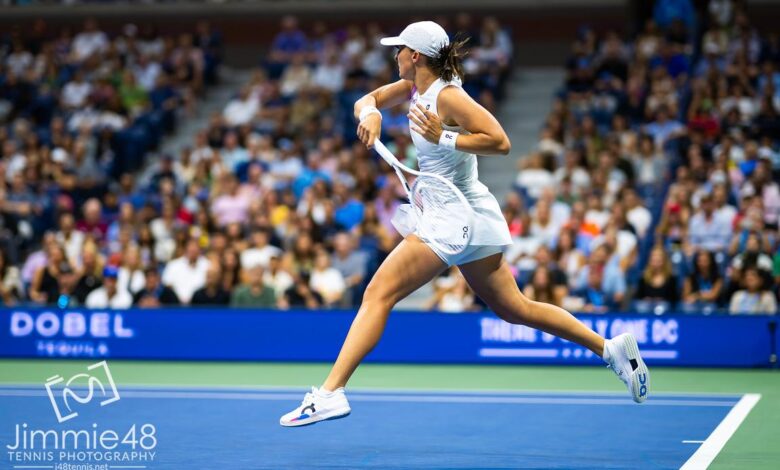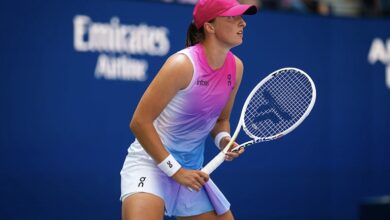IGA SWIATEK: THE FIVE KEYS TO HER MIGHTY FOREHAND

Just a few days before Wimbledon starts, Marion Bartoli gives us a detailed breakdown of Iga Swiatek’s forehand technique.
Iga Swiatek started to shake things up as soon as she set foot inside Roland-Garros stadium. In 2020, her second appearance at the tournament, she became the lowest-ranking woman (No.54) to triumph in Paris, at the tender age of 19 and without dropping a single set. The Polish whirlwind had arrived, causing a stir in the women’s tennis world with her revolutionary playing style, in particular her topspin forehand that spins at more than 3,400 rotations/minute, putting her on a par with the most talented male topspin talents.
Three years (and three Coupe Suzanne-Lenglen wins) later, the World No.1 continues to wreak havoc with her distinctive forehand technique, which the majority of her opponents have not yet managed to tame. But what is the secret to this mysterious weapon that proves so dangerous on clay but can be used against her on faster surfaces?
Marion Bartoli – who was able to watch her from up close at Roland-Garros as the on-court interviewer and consultant for Prime Video – analyses the technical characteristics of this stroke.
1 – An extreme grip
It would be impossible to talk about Iga Swiatek’s forehand without mentioning her ultra-strong Western grip. “It’s a really extreme grip, from right underneath, that requires you to meet the ball in a certain way,” Marion Bartoli begins. “She comes to the ball with her racquet sitting horizontally, gripping it from below, with the palm of her hand facing upwards as opposed to down towards the ground, like most players. It’s extremely rare. Even the men who are able to add a lot of topspin to their forehead – such as Alcaraz, Ruud or Nadal – don’t play like that. It reminds me of the Spanish players in the 1990s, like Berasategui, Bruguera, etc. I don’t think I’ve ever played anyone with such an extreme grip.”
2 – Her own, unique way of preparing for the shot
Let’s look at the way in which Iga prepares to hit a forehand, with the head of her racquet in front of her face, as though it were a mirror she was looking into. “This is also very specific to her,” explains the 2013 Wimbledon champion. “It’s the easiest and safest way to position this extreme grip. If she held her racquet to the side, like most other players do, she would risk finding herself in a more neutral position, especially in moments of high stress. Here, she just has to pull her racquet in order to get it in the right position.”
In the following photo, we see that just before she plays the shot, the head of Iga’s racquet is completely facing the floor, which is a consequence of her famous grip.
3 – Hitting with her arm bent to boost spin
Iga is not a fan of hitting her forehands with a completely straight arm, a technique made famous by Roger Federer and Rafael Nadal, and later imitated by Carlos Alcaraz. This, again, comes down to her grip. “If her arm was straight, she wouldn’t be able to generate the wrist speed and the effect required with this grip,” elaborates the former World No.7.
Bartoli believes this is one of the limitations of this shot, particularly on faster surfaces, and especially on grass. “In terms of pure speed, a forehand played with a straight arm is more efficient. Swiatek has more difficulty playing direct winners. But, since she is still capable of accelerating, she uses her forehand in a different way. She uses it to push her opponent back, to stop them from coming to meet the ball off the bounce with her spin, and to find new angles in order to open up the court and finish the point off with her backhand, which is her strongest shot. This is what makes her so efficient on clay! The clay surface gives her more time to set her shot up, and it also allows her to add more topspin.”
4 – Finishing off like Rafa…or like Iga!
When we see photos of the final stage of Iga Swiatek’s forehand, it is clear there are no half-measures: she either finishes off very high or very low! And, unsurprisingly, this is also connected with her grip.
“She often finishes her shot on the same side, above her head, with a whipping movement like Rafa,” the former French No.1 explains. It might be to emulate her childhood idol, but it is undoubtedly another way of accentuating the topspin. And it is often out of necessity. “Once again, Iga needs time. In order for her to finish her shot on the other side, the opponent’s shot needs to be slow so that she can fully commit. Otherwise, it’s much easier for her to finish up high. When the point of impact is a bit later, lifting the racquet quickly can make up for this and help her hit through the ball. When you hit the ball late and still try to finish in front of your body, you risk losing control.”
5 – Huge momentum with every shot
This is the final link in the kinetic chain. Along with her grip, the position of her wrist when she strikes and the very specific way she rounds off her shot, coupled with her above-average explosivity, the World No.1 stands out thanks to her extremely bouncy shots.
“Since she can’t finish as high as the others, and since the ball naturally bounces higher on clay, she makes up for it by pushing hard with her legs when she plays her shot,” explains the 2011 Roland-Garros semi-finalist. “In almost all of the photos of her forehand, we see that she jumps really high. And if she doesn’t manage to get enough impulsion using her legs, this is when she will finish her swing above her head, like Rafa.”
As a consequence, when Iga Swiatek unleashes her mighty forehand, it usually leads to some spectacular photos. It might be a nightmare for her opponents, but it is a delight for photographers!



